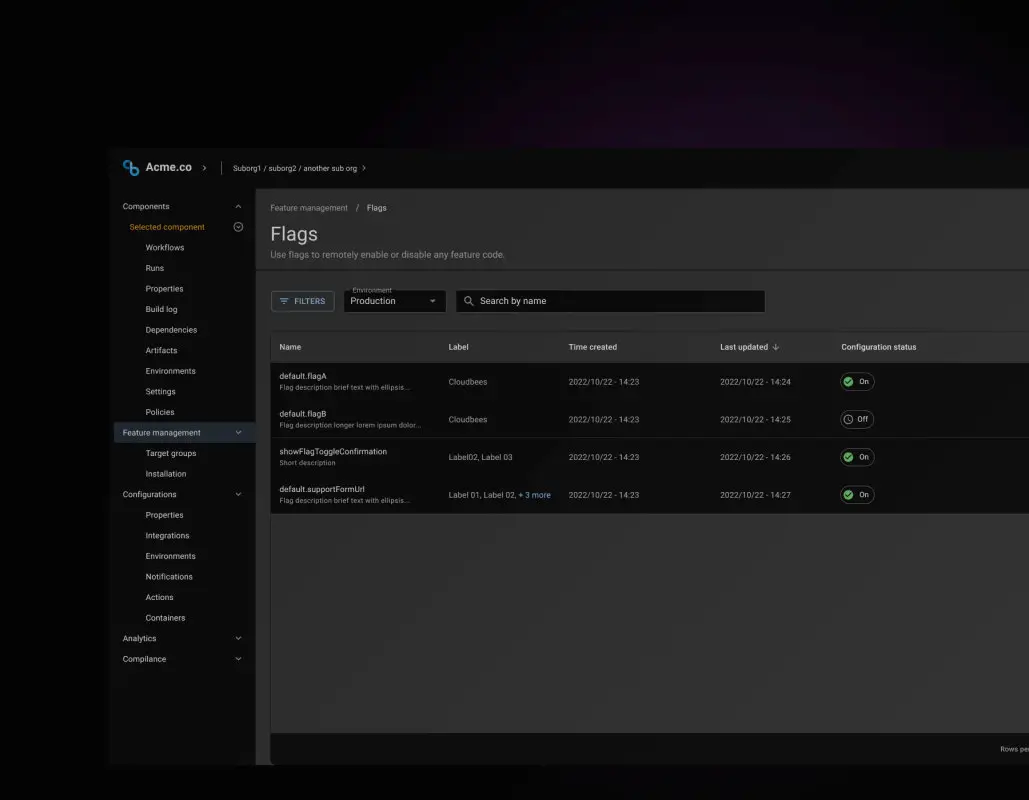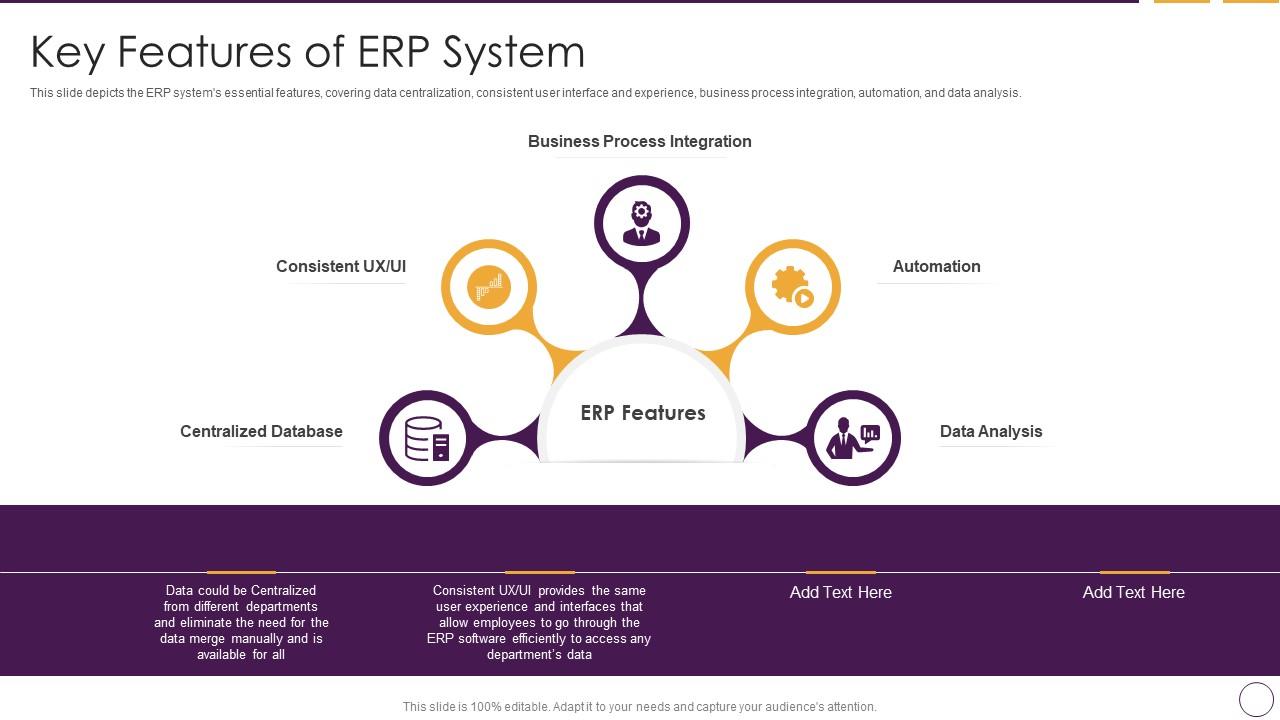
What are the Key Features of Automation Software: A Deep Dive
Automation software is characterized by key features such as workflow management, cost savings, mobile phone accessibility, process mapping, enhanced customer service, document management, increased productivity, and scalability. These features allow businesses to streamline their operations, reduce manual tasks, improve efficiency, and provide better service to their customers.
By automating repetitive and time-consuming processes, businesses can save valuable time and resources, resulting in cost savings. The ability to access and manage automation software through mobile devices enables flexibility and convenience. Process mapping helps visualize and optimize workflows, while document management ensures efficient storage and retrieval of important files.
Overall, automation software empowers businesses to operate more efficiently and effectively in today’s fast-paced digital landscape.

Credit: www.slideteam.net
Introduction To Automation Software
Automation software has evolved significantly in recent years, and it is essential to understand its key features in today’s context. The primary benefit of automation software is that it reduces the need for human intervention in various processes, thus improving workflow management, productivity, and scalability. Automated systems use pre-set logical parameters to perform actions or make decisions without the direct involvement of humans. This feature reduces errors, increases speed, and boosts quality, making it an essential tool for any organization. Automation software provides several features, including process mapping, document management, better customer service, mobile phone integration, and cost savings. Additionally, it streamlines the system and incorporates software tools, people, and processes to create a completely automated process. Basic automation is used to digitize, streamline, and centralize manual tasks.
Core Components Of Automation Software
Workflow Management: Automation software simplifies and streamlines workflow processes, enabling efficient task management and workflow automation for increased productivity.
Document Handling: The software facilitates centralized document storage, retrieval, and sharing, ensuring seamless document management for enhanced collaboration.
Process Mapping: Through visual representation of processes and workflow diagrams, automation software aids in clear process visualization and identification of bottlenecks for process optimization.
Streamlining Workflows
Automation software offers integral features for streamlining workflows and enhancing efficiency. One of the primary benefits is the cost savings it provides by reducing manual labor and minimizing errors. By enabling process mapping and document management, it ensures a more organized and structured approach to tasks. Moreover, it facilitates better customer service through improved response times and personalized interactions. The scalability of automation software allows for seamless adaptation to evolving business needs, promoting sustained productivity. Successful case studies highlight the tangible advantages of efficient workflow management, showcasing real-world examples of how businesses have optimized their operations.
Enhancing Productivity
Automation software offers key features that enhance productivity, such as workflow management, cost savings, better customer service, and document management. With automation, businesses can streamline processes, increase efficiency, and save valuable time, leading to improved productivity and overall success.
| Enhancing Productivity |
| How Automation Boosts Output |
Cost Reduction Strategies
Automation software offers several key features for cost reduction strategies, including workflow management, process mapping, and document management. With the ability to streamline routine tasks and remove human inputs, automation software can increase productivity, scalability, and ultimately lead to better customer service.
| Cost Reduction Strategies |
|
Improving Customer Service
Automation software can greatly improve customer service by streamlining workflow, increasing productivity, and reducing costs. Key features to look for include workflow management, process mapping, document management, and scalability. Additionally, automation can lead to better customer service through faster response times and more personalized interactions.
| Automation for Faster Response Times | Personalized Customer Experiences |
| Automation software is an essential tool for businesses looking to improve their customer service. By automating routine tasks, businesses can respond to customer inquiries faster and more efficiently. This not only improves customer satisfaction but also frees up time for employees to focus on more complex issues. | Another key feature of automation software is the ability to provide personalized customer experiences. With automation, businesses can track customer behavior and preferences, and use this information to tailor their interactions with customers. This can lead to increased loyalty and higher conversion rates. |
Mobile Accessibility
Automation software offers a range of key features that enhance efficiency and productivity in various tasks. Mobile accessibility is one such feature that enables users to manage tasks on the go. With the ability to access automation software from their mobile phones, users can stay connected and productive even when they are not at their desks. This feature allows for flexibility and convenience, ensuring that important tasks can be monitored and managed anytime, anywhere.
Additionally, security concerns are a crucial aspect of automation software. It is important to implement solutions that prioritize data security and protect sensitive information. By incorporating robust security measures such as encryption and multi-factor authentication, automation software ensures that data remains secure and protected from unauthorized access.
Decision-making And Automation
The key feature of automated systems is the use of pre-set logical parameters to perform actions or make decisions without direct human involvement. Automated decision-making can be used in various ways in administrative decision-making. It streamlines systems by removing human inputs, decreasing errors, increasing delivery speed, boosting quality, minimizing costs, and simplifying processes. It incorporates software tools, people, and processes to create a completely automated workflow management system, resulting in cost savings, better customer service, enhanced productivity, and scalability.
The Role Of Ai And Machine Learning
The role of AI and Machine Learning in automation software is crucial for enhancing efficiency and accuracy. Predictive analytics enables businesses to anticipate future outcomes based on historical data, optimizing decision-making processes. AI-driven process optimization leverages advanced algorithms to continuously improve workflows and identify areas for enhancement. These features empower organizations to streamline operations and drive sustainable growth.
Credit: www.scnsoft.com
Key Features For Specific Sectors
Automation software has a range of features that can be useful for specific sectors. For sales funnel automation, workflow management is crucial to ensure smooth sailing through market currents. Integral cost savings and better customer service can also be achieved through the use of automation software.
Marketing automation essentials include segmentation capabilities, which allow you to tailor your messages to specific groups, improving relevance and response rates. Document management and productivity are other key features to look for in automation software.
For successful content marketing automation, tools that streamline workflow, enhance targeting, and boost engagement rates are crucial. When evaluating content marketing automation tools for email campaigns, scalability and process mapping are important features to consider.
Automated systems use pre-set logical parameters to perform actions or make decisions without the direct involvement of a human being. Basic or task automation is used to digitize, streamline, and centralize manual tasks such as distributing onboarding materials to new hires or forwarding documents for approvals.
Scalability And Future Growth
Automation software offers key features that contribute to scalability and future growth for businesses. Planning for expansion becomes easier with the implementation of automation solutions. These tools allow businesses to adapt and scale their operations without the need for extensive manual labor.
One of the primary benefits of automation software is workflow management. It streamlines processes and ensures tasks are completed efficiently. This results in increased productivity and cost savings for the business.
Another important feature is the ability to map out and visualize processes. This helps businesses identify areas for improvement and optimize their operations.
Automation software also enhances customer service by providing better response times and personalized experiences. It allows businesses to automate routine tasks, freeing up time for employees to focus on more complex customer needs.
Document management is made easier with automation software, as it provides a centralized location for storing and organizing important files. This improves accessibility and reduces the risk of lost or misplaced documents.
Finally, scalability is a key feature of automation software. It allows businesses to handle increased workloads and adapt to changing demands. This flexibility is crucial for future growth and success.
Integration Capabilities
Integration capabilities are key features of automation software that allow for seamless connectivity and collaboration between different systems and platforms. With integration capabilities, businesses can streamline their processes, improve efficiency, and enhance productivity by automating tasks and sharing data across various applications.
| Integration Capabilities |
| Automation software offers seamless integration with various systems, allowing for the smooth exchange of data and processes. Successful integration examples include linking CRM platforms with marketing automation tools to streamline lead management and customer communication. Additionally, the integration of accounting software with inventory management systems enhances financial visibility and control, leading to more informed business decisions. |
Security Aspects Of Automation Software
Automation software plays a crucial role in managing and streamlining various processes within an organization. When it comes to security, protecting sensitive data is of utmost importance. The software should have robust security measures in place to safeguard confidential information from unauthorized access.
Compliance and regulatory considerations are also essential when implementing automation software. It is crucial to ensure that the software complies with industry-specific regulations and standards to maintain data integrity and privacy. This includes adhering to data protection laws, industry-specific regulations, and implementing secure data storage and transfer protocols.
User Experience And Interface Design
Automation software offers several key features that enhance user experience and interface design. Designing for ease of use is crucial, as it ensures that users can navigate the software effortlessly. With customization options, users can personalize the software according to their specific needs and preferences. This allows for a more tailored experience, increasing efficiency and productivity. Additionally, automation software often includes workflow management capabilities, which help streamline processes and improve overall productivity. Mobile phone integration is another key feature, enabling users to access and manage the software on-the-go. Furthermore, automation software offers process mapping functionalities, allowing users to visualize and optimize their workflows. Document management capabilities ensure easy organization and retrieval of important files. Overall, the key features of automation software contribute to better user experience, increased productivity, and cost savings.
Implementation Challenges
Automation software implementation can face common pitfalls, leading to challenges. To ensure smooth deployment, it’s essential to follow best practices. These include thorough process mapping to understand existing workflows and identifying areas for automation. Moreover, focusing on workflow management and document management is crucial for effective implementation. Additionally, prioritizing better customer service and cost savings can lead to successful deployment. Scalability and mobile accessibility are also key features to consider for seamless integration into existing systems. Overall, addressing these aspects can help mitigate challenges and optimize the benefits of automation software.

Credit: www.facebook.com
Training And Support
Training and support are key features of automation software that ensure the successful implementation and usage of the tool within your organization.
Educating your team is crucial to ensure they understand the functionalities and benefits of the automation software. This can be achieved through training sessions, workshops, and educational materials.
In addition to initial training, ongoing support structures are necessary to address any issues or questions that may arise. This can include a dedicated support team, online forums, and documentation resources.
By providing comprehensive training and ongoing support, your team will be equipped with the knowledge and assistance they need to effectively utilize the automation software, maximizing its benefits for your organization.
Evaluating Automation Software
Key features of automation software include workflow management, cost savings, scalability, and better customer service. These systems use preset logical parameters to perform actions without direct human involvement, streamlining processes and increasing productivity. Automation also offers document management and mobile accessibility, enhancing overall efficiency and functionality.
Case Studies
Automation software offers key features such as workflow management, cost savings, better customer service, and scalability. These tools streamline processes, enhance productivity, and reduce manual intervention, resulting in efficient and agile operations. With automation, organizations can achieve improved efficiency and optimized resource utilization.
| Case Studies |
| Success Stories |
| When evaluating content marketing automation tools for email campaigns, focusing on key features that streamline workflow, enhance targeting, and boost engagement rates is crucial. Segmentation capabilities is the best capability: effective tools should allow you to segment your audience based on various criteria such as demographics, behavior, and past interactions. This ensures that you can tailor your messages to specific groups, improving relevance and response rates. |
| Before automating your sales funnel, set clear, realistic goals for each stage and track key metrics like conversion rates and revenue. It’s like sailing with a well-charted map and a trusty compass, ensuring smooth sailing through market currents. |
| Workflow management, integral cost savings, mobile phone, process mapping, better customer service, document management, productivity, and scalability are some features of an automated system. The key feature of such systems is the use of pre-set logical parameters to perform actions or make decisions without the direct involvement of a human being at the time of decision. |
| Basic or task automation takes simple, routine tasks and automates them. It is used to digitize, streamline, and centralize manual tasks such as distributing onboarding materials to new hires, forwarding documents for approvals, or automatically sending invoices to clients. |
| Process automation streamlines a system by removing human inputs, which decreases errors, increases speed of delivery, boosts quality, minimizes costs, and simplifies the business process. It incorporates software tools, people, and processes to create a completely automated workflow. |
Future Trends In Automation
Automation software is revolutionizing industries by streamlining workflow and enhancing productivity. With its cost-saving capabilities, businesses can now efficiently manage processes while providing better customer service. One of the key features is workflow management, which ensures smooth operations and mobile phone accessibility. Additionally, the scalability of automation software allows for future growth and expansion. The integration of document management and process mapping optimizes the system, while segmentation capabilities offer personalized communication. Moreover, automation systems reduce errors and minimize costs by removing human inputs, ultimately creating a completely automated workflow. As we look towards the future, emerging technologies and predictions for the next decade will further propel automation software to new heights.
Frequently Asked Questions
What Are Some Features Of An Automated System?
Automated systems use pre-set logical parameters to perform actions or make decisions without human involvement. They streamline processes, increase productivity, reduce costs, and improve quality and reliability. Key features include workflow management, cost savings, document management, better customer service, scalability, and mobile phone integration.
Basic automation digitizes routine tasks, while process automation removes human inputs to optimize performance. Successful automation strategies require clear goals and tracking of key metrics. Segmentation capabilities are crucial for content marketing automation tools.
What Is An Automation Feature?
An automation feature is a capability that allows tasks and processes to be performed automatically without human intervention. It digitizes, streamlines, and centralizes manual tasks, such as sending invoices, distributing onboarding materials, and forwarding documents for approvals. Automation saves time, reduces costs, increases productivity, and improves efficiency.
It eliminates errors, speeds up delivery, enhances quality, and simplifies business processes.
What Are The Key Points Of Process Automation?
Process automation streamlines systems by removing human inputs, reducing errors, increasing speed, boosting quality, and cutting costs. It involves software tools, people, and processes to create a fully automated workflow. Key benefits include cost reduction, increased productivity, high availability, reliability, and optimized performance.
What Are The Key Benefits Of Automation?
The key benefits of automation include cost reduction, increased productivity, high availability, increased reliability, and optimized performance. Automation streamlines processes, eliminates manual tasks, and improves efficiency, resulting in time and cost savings. It also reduces errors, enhances consistency, and allows for scalability.
Overall, automation improves business operations and helps organizations achieve their goals more effectively.
What Are The Main Features Of Automation Software?
Automation software offers features such as workflow management, cost savings, mobile phone compatibility, process mapping, better customer service, document management, increased productivity, and scalability.
How Can Automation Software Save Time And Reduce Costs?
Automation software helps to streamline processes, eliminate manual tasks, and improve efficiency, resulting in time and cost savings for businesses.
What Is The Role Of Process Mapping In Automation Software?
Process mapping in automation software allows businesses to visually represent and analyze their workflows, helping them identify areas for improvement and optimization.
How Does Automation Software Enhance Customer Service?
Automation software enables businesses to automate customer service processes, such as ticket management and response generation, ensuring timely and efficient customer support.
What Is The Significance Of Document Management In Automation Software?
Document management features in automation software help businesses organize, store, and retrieve documents efficiently, reducing manual paperwork and improving document accessibility.
How Does Automation Software Improve Productivity?
Automation software automates repetitive and time-consuming tasks, allowing employees to focus on more strategic and value-added activities, thus boosting overall productivity.
Conclusion
Automation software offers key features such as workflow management, cost savings, better customer service, and scalability. These functionalities streamline processes, enhance productivity, and improve overall efficiency. With automation, businesses can achieve increased productivity and optimized performance while reducing costs and minimizing errors.
